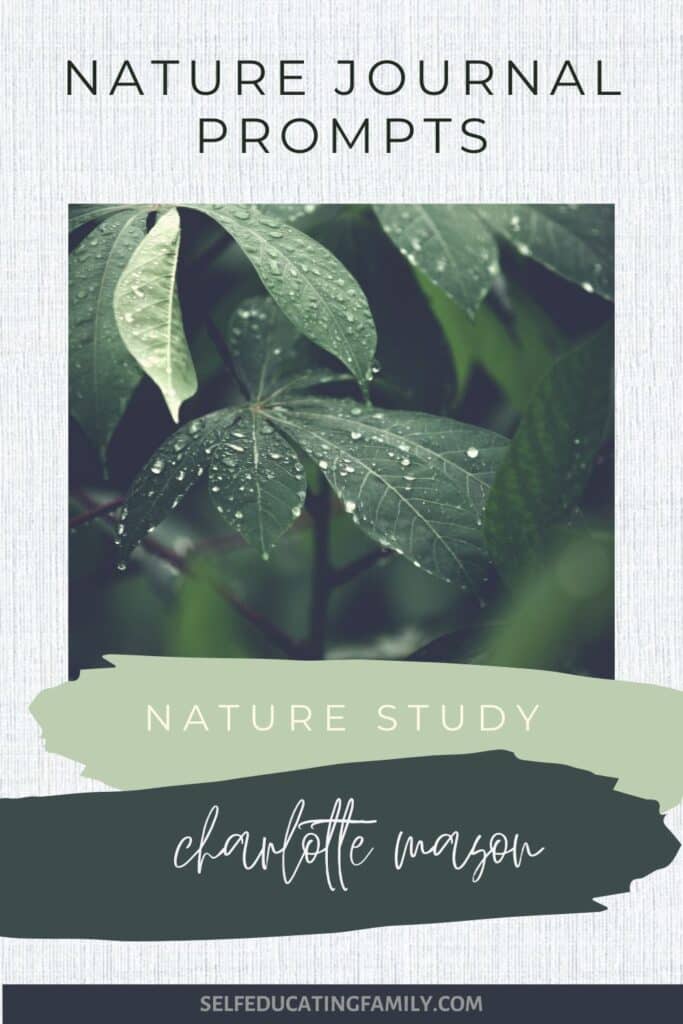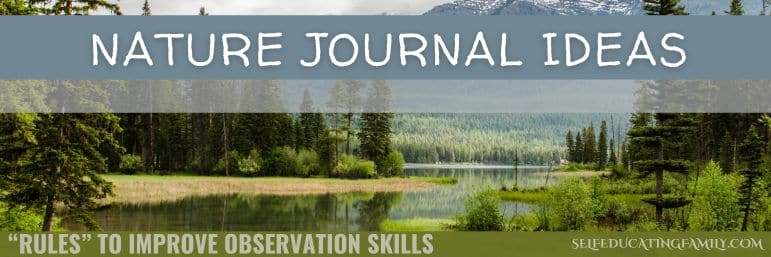Nature Journal Prompts
What’s inside: Nature Journal Prompts for when you or your young naturalist feel like you have no idea what to put in your journal: You’ll find several prompts to get you moving again.
This post may contain affiliate links. If you find my content valuable and make a purchase through one of my links, I will earn a commission at no cost to you, which helps me keep this blog going so I can help you even more! I recommend products I trust and/or use myself, and all opinions I express are my own. Read the full disclaimer here.
When you get stuck: Use Nature Journal Prompts!
Do you feel like your young naturalist gets stuck sometimes with their nature journal?
When they ask, “What should I put in my journal? Can I put a nice drawing of a stick?” And then you have 100 drawings of sticks. Maybe a rock here and there. Not a lot of variation.
So here’s what to do when you get stuck. Any of these can be a starting point for an entry in your journal.
1. Look around
Questions to ask yourself when you look around:
- What colors are prominent today? How many distinct hues?
- What shapes do you see? Describe nature’s shapes.
- When I look around, how can I describe the feelings of what I see? Is it cheery? Gloomy? Fresh? Alive? Quiet? Peaceful? Turbulent? Enlivening? Give your best adjectives to describe the emotions of your surroundings.
- Stare at your surroundings for 30 seconds. Close your eyes. What do you see now? Can you paint the picture in your mind? What impresses you the most?
2. Listen
Some people listen better with their eyes closed; some don’t. Here are listening prompts:
- Focus intently on the sounds closest to you. What do you hear? What do you think is making the sounds?
- Now listen “far off”. Can you hear any animals? What about wind – plants rustling? Can you hear any man-made sounds?
- Can you hear any of the people you are with?
- Describe any sounds you don’t know with words. Onomatopoeia can be very descriptive.
3. Ask Questions
Questions can be a great way to get moving again.
- You can write down any questions you think of in your journal. Then see if you can answer them. If you can’t, maybe you can answer them later.
- John Muir Laws gives 3 prompts for deeper nature study – these are fantastic starters if you are stuck:
- I notice…
- I wonder…
- It reminds me of…
- Ask the famous 5 Ws: “Who, what, where, why, when (and sometimes how)?”
4. Look for your focus of the semester
If you are studying a chapter in Anna Botsford Comstock’s The Handbook of Nature Study, then you probably have selected a focus for the semester. When you are out doing nature observations, remember to see if you can recall or locate what you are studying.
For instance, if you are studying mammals:
- Do you see any animals?
- Do you see tracks or scat?
- What habitats do you see that your animal might live in? What kinds of food supply is nearby?
5. Get a Different Point of View
Perspective is also known as “point of view”. It’s as if you are the camera lens and you can look at something from a different starting spot.
So change it up!
Here are a few ideas:
- What can I see if I lay on the ground?
- What can I see by looking up?
- How does it change if I climb to a higher vantage point?
- Can I get more detail by looking really closely?
- Can I describe a panoramic view?
6. List it!
Sometimes when you are “stumped” for what to put in your nature journal, think of adding a list. Here is an example list prompt:
- List ways your scene exemplifies the season you are in. List ways it will change and ways it will stay the same. e.g.:
- Dixon Lake Observations Right Now
- Clear, sunny, fall day
- Leaves are changing color and falling
- Rustling leaves on the path
- Lake is busy with birds
- Squirrels are in the trees. Nests are starting to be visible.
- Changes I think I will see in winter
- Snow
- The lake will freeze
- The summer birds will not be here
- The trees will be bare except for the pines
- I’ll be able to see the nests of the squirrels clearly.
- Dixon Lake Observations Right Now
7. Be a detective
Try approaching your nature area like a detective searching for clues.
- Who was here recently (both human and animals)?
- Did they leave anything behind? Did they leave a trace?
- Was there no trace of anyone or any animal? What about the path you used?
- List evidence you find to support what you think.
Have some fun in nature!
I hope these nature journal prompts can help you get a deeper relationship with the world around you.
Keep Learning
More Study
- Three prompts for deeper nature observation | John Muir Laws
- Nature Journaling Prompts | Hike and Draw
You don’t need to be an artist. You don’t need to be a biologist. All you have to be is curious about nature!
— Hikeanddrawnyc

If you would like more detail on working with a nature journal, then try my One-Week Challenge: Get Outdoors with Nature Study.











